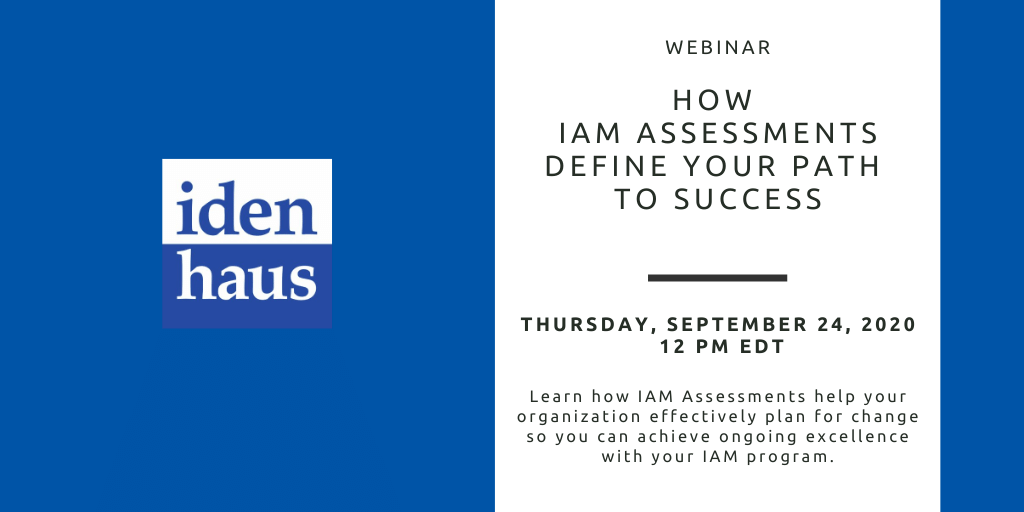An IAM Assessment helps guide your program to Identity Management success, the first time around.

The most common benefit from Identity Management is moving from high-touch, human-driven processes to a policy-driven, automated approach for identity lifecycle management. Considering that more than fifty percent (50%) of IAM implementations fail the first time around, this isn’t a small feat. It takes an organization that is well managed, that understands its mission, and that uses its staff and resources efficiently. A successful IAM program requires an organization to identify its long- and short-term goals, set program priorities based on value to the business, and understand the strengths and struggles of its staff and business processes. This blog will help you understand the importance of an IAM Assessment and provide a model to follow as you prepare to implement your own program.
[feature_box style=”10″ only_advanced=”There%20are%20no%20title%20options%20for%20the%20choosen%20style” alignment=”center”]
Before you continue reading, how about following us on LinkedIn?
[/feature_box]
What Is an IAM Assessment?
An IAM Assessment helps organizations establish a roadmap for the future of their Identity Management program. An assessment examines how to solve your identity-related problems, identifies the gaps in technology and business processes, defines how different systems need to come together to support the future state, and lays out an implementation plan for the IAM program.
How does an IAM Assessment improve the probability of Identity Management Success?
- Clarify the Identity Management program vision and understand organizational priorities
- Inform thinking and decisions with analysis and research
- Identify unmet needs and new opportunities to add value
- Generate executive support, leadership buy-in, and cross-functional teamwork
- Mitigate risk and greatly improve the probability of Identity Management success
IAM Assessments can be broken down into three components: technology, people, and process. The technology and process challenges are best understood by conducting interviews with key staff, evaluating current systems to document the current state, and mapping out the processes around the user lifecycle (join, move, leave). As these challenges are better understood, the team can then evaluate its people with regard to the required skill sets needed to realize the program objectives. The assessment should identify critical success factors and address any capability gaps.
Elements of IAM Assessments
Developing a comprehensive IAM Strategy and Roadmap involves (1) thinking through and detailing solution elements, (2) linking IAM opportunities to the business value they deliver, and (3) creating a visual roadmap that documents the plan and project dependencies. The Roadmap helps ensure that the plan will work and that the elements (opportunities, tasks, and resources) will lead to the desired results. If a formal assessment and plan are not prepared upfront, when the IAM Program is being planned, the team will have a difficult time maintaining executive support, receiving adequate funding, and maturing the IAM platform.
IAM Assessments are the preferred process in planning enterprise-class solutions. Here is a guide to getting that done:
- Conduct interviews with key technical and business staff to identify strengths and challenges
- Assess the current technical environment: directories, applications, systems
- Identify and prioritize opportunities to leverage IAM to support automation, self-service, enhance security, and provide better auditing and controls
- Facilitate opportunity prioritization with both business and technical stakeholders
- Evaluate dependencies between opportunities and call them out on the roadmap
- Establish detailed action plans (e.g., objectives, resources, roles, responsibilities) to support the implementation
- Create an IAM Roadmap that communicates the business and technology plans to the organization. With a roadmap, the team can clearly explain the goals of the program, show when new capabilities will be deployed, socialize the plan, and provide a framework for decision making.
Learn how How IAM Assessments Define Your Path to Identity Management Success in our upcoming training on September 24 at 12 PM EDT.
IT Executives and other business leaders are responsible for guiding their organizations through these changes with new IAM strategies that directly affect employees, their access, and how risk is managed.
Business leaders need to set direction and provide a clear path to meeting IT goals that align with evolving business strategies.
- What steps should you take to help ensure ongoing alignment?
- Will you need to automate more user management functions or support additional integrations?
- Will you need to rethink your system deployment method?
- Will you need training and communications to manage change and drive user adoption?
- How will emerging or new standards and regulations impact your existing framework?
In this webinar, you will learn how an IAM Assessment and Solution Roadmap can help your organization effectively plan for change so you can achieve ongoing excellence with your IAM program.
Reserve your spot today.
Follow @Idenhaus on Twitter and subscribe to our Identity Management biweekly or our healthcare IT biweekly newsletter.
Idenhaus is honored to be featured in the Top 10 Identity Governance and Administration Consulting/Service Companies of 2019.
By going to work quickly to solve the most challenging cybersecurity and identity management problems, Idenhaus takes the pain out of securing corporate information and assets for companies that aspire to maximize their potential in this digital age. Click here to contact us








